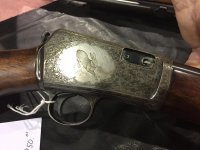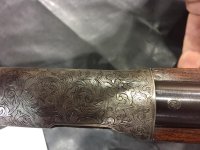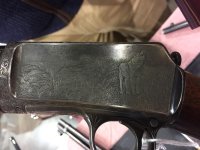After market engraved. It doesn't really follow any of the factory patterns that were around. But custom engraving was available too..
The animal scenes look more finely cut and detailed than the scroll work IMO. Something you don't generally see. Usually the opposite.
A factory engraved gun would be a 'Deluxe Grade'. As such would have at least hand checkering , pistol grip cap, jeweled bolt. Usually extra fancy walnut or even other species wood was the pick. ,,Unless the customer didn't order any,,which is an easy way to explain away any question of why such a full engraved factory job would have such plain wood, no checkering, ect. Sorry no factory records to say otherwise.
Collectors call the rifles a Plain Deluxe if they have non-fancy wood (plain wood) but the deluxe features of grip cap and jeweled bolt.
There's so few real Deluxe and engraved Factory 63 and other 22 Winchesters around, I think the collectors may have gone to creating some of the terms to try & describe them
The proof marks are usually hint of wether the engraving is aftermarket on a job like this.
The full coverage on the rec'vr was worked around the existing proof mark on the top of the frame.
If done at the factory, the entire gun would have been brought to the engraver before proof marks had been added, though the gun would have had a proofing session to affirm it's status.
Then the engraving and final finish (blue, plating, whatever) would be completed.
The W/P proof marks then added to the final blued/plated and finished gun after perhaps another trip through the range.
The proofs on a full engraving job can sometimes be rather crudely stamped right over and into the existing engraving like it was 'in the way'.
Or sometimes the proofs are moved to one side or the other slightly to take advantage of a blank area on both bbl and rcv'r. They did want them to line up on both bbl & frame as a rule.
The above is an easy way to spot upgraded Model 12 and Model 42 shotguns. Anything above the #1 pattern (IIRC) has bbl engraving at the breech and with a vent or solid rib on the gun the proof marks are off to the left side. That's right where the wedge of scroll work on the bbl is placed.
On most upgrades, the original proof mark is simply engraved around and ends up sitting neatly inside the scroll work as above.
On a factory gun, they didn't proof mark them before engraving,,the engraver did their thing, then the proof mark added.
In these cases the Proof mark was then applied outside of the engraving pattern. Usually just forward of the wedge of scroll work.
The bbl choke markings on that side are also a hint as they were moved foreward for the same purpose of allowing the engraving to fit in that space.
But, W/P proof mark punches can be made. Old marks can be removed and new ones relocated to wherever they are needed ,,and so even if it looks 'correct',,there's nothing that says it really is.
As always,,the Proof Mark punch stamping should be 'through' the blue or plating. Not underneath it.
So it can and usually does slightly break the surface of the finish when applied and should be sharp and the surrounding metal around it's edge disturbed and moved upwards just slightly.
This goes for any Mfg or Proof House I can think of.




